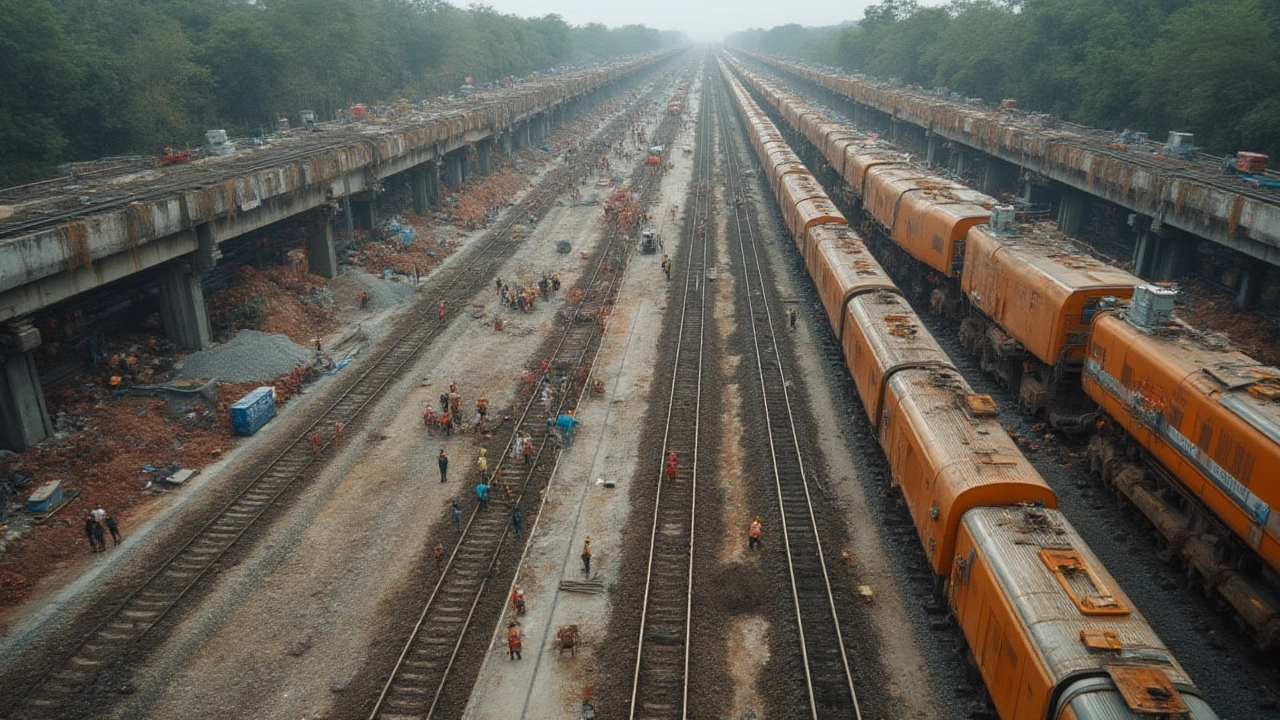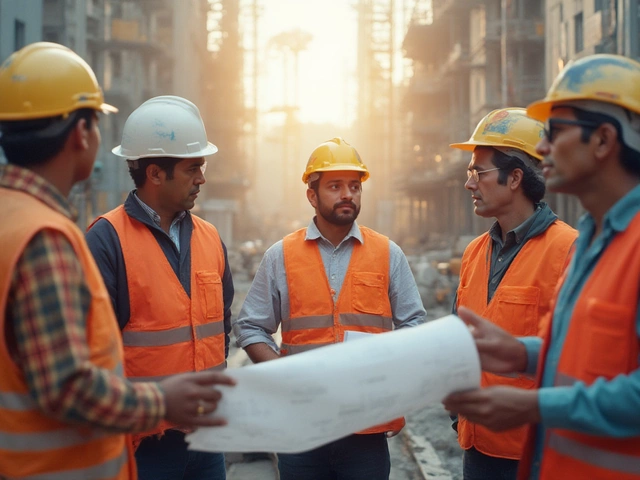You probably hear the words “Tier 1 contractor” thrown around whenever skyscrapers take shape or huge infrastructure projects make the news. It's not just construction lingo, either. The idea of Tier 1 contracting is a bit like spotting the lead actor in a blockbuster movie: everyone else is supporting the show, but the Tier 1 folks are calling most of the shots, taking all the big risks, and making sure each scene comes together.
This world is intense. These contractors run teams that can fill a stadium, control budgets that make most bank accounts look puny, and answer to clients who expect their billion-dollar vision to pop up on cue. Being a Tier 1 contractor means more than playing with the big toys. It's a mark that says, “We’re built for the heaviest lifting there is.”
What Makes a Contractor ‘Tier 1’?
Let’s get straight to it: a Tier 1 contractor isn’t just bigger than others—they’re responsible for the whole project, from the first handshake to handing over the keys. In simple terms, this is the main company hired by the client (could be the government, a Fortune 500, or anyone building megaprojects), and every other contractor works *under* them. They’re the quarterback, everyone else is running plays as directed.
A Tier 1 contractor manages the entire design, engineering, and actual construction, but they also farm out big chunks of work to Tier 2 and Tier 3 subcontractors—think electricians, plumbers, steelworkers, even caterers sometimes. While a Tier 2 might focus only on pipes in one section of the building, a Tier 1 has to worry that the pipes, wires, air conditioning, elevators, and everything else fits together perfectly on time.
The sort of projects Tier 1 contractors handle is massive. We’re talking new airports, Olympic stadiums, national bridges, even major hospital complexes. For a sense of scale, a Tier 1’s contract value usually starts at $100 million and quickly heads north. In 2023, over half the top 20 Tier 1 contractors each had annual turnovers topping $2 billion. That’s why only the largest, most experienced firms get this label.
Besides size, Tier 1 contractors jump through some pretty hefty hoops to prove they can deliver at this level. That means robust health and safety records, stacks of insurance coverage, strict compliance with government rules, and the internal firepower to run armies of workers and match last-minute changes from clients. Many government jobs legally require hiring a verified Tier 1, mainly for liability reasons and risk management.
The line between Tier 1, Tier 2, and Tier 3 can feel blurry, but the money, size, and breadth of the contract usually make it obvious. While it's possible for a Tier 2 contractor to “move up” and grab a Tier 1 slot after years of experience and growing their cash reserves, new or small contractors never just walk in at this level.
When you're reading about a new skyscraper, bullet train, or mega-mall, it’s always a Tier 1 pulling the strings, hiring hundreds of smaller firms, making sure all the parts show up and fit. Without these guys, nothing gets off the ground.
Roles and Responsibilities on Mega Projects
The truth is, Tier 1 contractors do far more than just build stuff. Think of them as orchestra conductors with power tools, managing so many moving parts it’ll make your head spin. For every high-profile launch, thousands of tiny tasks happen behind the scenes—Tier 1 teams make sure the right expert is in the right place with the right material at exactly the right minute.
Much of their job is about coordination. That means planning workflows that keep 1,000 workers safe, tackling legal paperwork (sometimes stacks taller than the buildings themselves), negotiating with local governments, and juggling shifting budgets. Delays are their daily enemy: weather issues, supply chain hiccups, even unexpected archaeological finds can throw projects off schedule. A tier 1 contractor has backup plans for their backup plans, just to keep the train on the tracks.
A huge part of their responsibility is regulatory compliance. They must make sure every nut and bolt matches national and sometimes international standards. Get it wrong—even on a tiny detail—and fines can soar by millions, or entire projects can get shut down. Because of that pressure, Tier 1 companies have entire departments that just handle contracts, risk analysis, and compliance.
Here’s a small taste of their typical duties:
- Developing project plans and detailed designs
- Managing mega-budgets and allocations
- Hiring and monitoring all subcontractors (Tier 2/3)
- Ensuring strict workplace safety and environmental standards
- Communicating with clients, public officials, and even the media
- Troubleshooting problems as they occur—sometimes hourly
- Certifying final completion and quality so the client pays up
It’s not just about the technical nitty-gritty. Tier 1 contractors shape whole neighborhoods. If you’ve visited Manhattan’s Hudson Yards, Sydney’s new airport, or the latest gigafactory in Nevada—those projects were led by Tier 1s. Their work affects traffic, local economies, and the skyline for generations.
Decision-making speed is make-or-break. If an unexpected storm floods the foundation pit, the Tier 1 must pull in extra pumps, reorder timelines, and possibly even renegotiate permits—all before breakfast. This pressure means Tier 1 teams are built for stress: experienced leaders, rapid communication, zero room for indecision.

Why Do Clients Hire Tier 1 Contractors?
If you’re wondering why not just hire dozens of separate specialists, the answer is simple: risk and efficiency. For billion-dollar projects, the risks of failure, delay, or legal trouble are too high for anyone but a Tier 1. By putting one super-capable firm in charge, clients cut down on finger-pointing and avoid the chaos of managing hundreds of smaller vendors independently.
Tier 1 contractors bundle up the entire headache—design, build, compliance, logistics—into one neat contract. The client pays for peace of mind, knowing there’s a single company responsible if anything goes sideways. That's not just helpful, it's essential insurance.
Here’s another side: major clients like governments or multinational companies have strict tenders—they legally have to prove every safety, wage, and environmental law is being followed. Tier 1s have a history they can point to. These projects attract international attention, and mistakes can make front-page news, which is why only the most reliable names get the job. Remember, the collapse of a single major bridge or subway line can lead to years of lawsuits and lost trust.
Data backs this up. In 2024, about 82% of contracts over $500 million in the U.S., UK, and UAE went to Tier 1 contractors—according to the Global Construction Leadership Report. The rest were typically government-to-government (like military bases) or joint ventures where even multiple Tier 1s teamed up.
If you’re a middle manager on a megaproject, having one point of contact makes your life easier. You know who to call when a supplier is late or if new zoning rules wreck the original plans. And yes, Tier 1s charge more—but the goal is fewer surprises later on.
Here’s a table comparing the cost and risk:
| Type | Contract Value Range | Main Focus | Common Risk Handled |
|---|---|---|---|
| Tier 1 Contractor | $100M - $5B+ | Full project delivery | Financial, schedule, legal |
| Tier 2 Contractor | $5M - $100M | Specialist packages | Technical |
| Tier 3 Contractor | $100K - $5M | Labor/subpackaging | Workmanship |
Tier 1s take on the scariest risks like schedule slippages, design errors, or environmental disasters. Clients pay extra, but the protection is worth it.
How to Become a Tier 1 Contractor
Sorry, there’s no quick cheat code here. Tier 1 status isn't just about having a fancy head office or a nice logo. These companies spend decades building up their cash reserves, technical team, equipment, and ironclad reputation. For most, the journey starts as a Tier 2: handling a few specialized packages on large jobs, building a list of happy clients, keeping safety perfect, and always finishing on time.
As they rack up wins, companies gradually bid for bigger, riskier work. They invest in employees who know how to scale up, hire smart logistics folks, and put millions into training. Another step: heavy investment in software and systems that track thousands of moving parts, like digital twins or BIM (Building Information Modeling) platforms. No client is trusting a $1B project to someone managing tasks on a spreadsheet or notepad.
Regulatory approval comes next. To be considered Tier 1, companies often go through rigorous audits by governments, major banks, and insurance firms. They need the sort of financial resilience where even a huge unexpected loss won’t bankrupt them. In Australia, for example, there’s an official “Tier 1” prequalification for government jobs, including proving $500M+ annual turnover and five years of large project delivery.
If you run a growing construction biz and dream of hitting Tier 1 someday, here’s what helps:
- Flawless safety and compliance records year after year
- Major bonding and insurance capacity (think $100M+ per claim)
- Consistent, on-time project delivery and client satisfaction
- Building deep specialty in key sectors (transport, energy, healthcare)
- Sticking to new tech and project management methods
- Training a leadership bench able to handle chaos
Most Tier 1s have a story of surviving at least one big disaster. Mistakes happen, but the best learn fast, fix the mess, and don’t let their reputation tank. The pipeline of work, access to capital, and iron nerves set these companies apart.

The Future of Tier 1 Contractors: Trends and Tips
The past decade shook up the Tier 1 world. Big firms had to adapt to climate change pressures, supply chain glitches, and the demand for speedier, greener construction. These days, the best Tier 1s aren't just good at building—they're tech-savvy, eco-focused problem solvers.
Prefabrication and modular building methods are some of the changes transforming mega-projects. More Tier 1s use off-site factories to build entire hotel rooms or bathrooms, then ship them in, saving months on site. Sustainability matters too. Clients now demand lower carbon footprints, more recycled materials, and designs that survive extreme weather. So, Tier 1s partner with eco-experts and constantly hunt for new processes or green tech to gain an edge.
Digital tools are everywhere. Drones map construction sites in minutes. Robots dig, pour, and scan for defects. Tier 1s invest millions in “smart construction,” because mistakes cost millions and data can save days or weeks. It’s common now for these giants to hire coders and data analysts, not just engineers and electricians.
Getting picked as a Tier 1 contractor is ultra-competitive. Procurements aren’t just about price anymore. It’s about diversity, inclusion, social impact, and working with local suppliers. In the UK, firms bidding on HS2 and Crossrail had to show plans for local jobs, apprenticeships, and even local sourcing targets—not just technical muscle.
Tips for anyone in the game or curious where the industry is heading:
- Stay on top of digital trends—BIM, drones, and data are now essentials
- Build relationships with smaller, local suppliers—the big guys need partners they can trust
- Don’t ignore green practices. LEED certification, carbon tracking, and smart waste management are winning bids
- Diversity and inclusion add real value on modern projects
- Embrace resilience—not every plan survives contact with reality, but having backup plans does
The best Tier 1 contractors aren’t stuck in the past. They evolve constantly, learning new tech, winning over communities, and delivering the impossible. Think of them as the lead actors who make the impossible blockbuster real, again and again. You’re not just watching buildings rise—you’re watching the future take shape, one megaproject at a time.
So next time you spot a skyline-changing crane, or read about a new city district, remember: there’s a Tier 1 contractor at the heart of it, pulling together expertise, money, tech, and sheer nerve. That’s the real magic behind the world’s biggest projects.


Write a comment